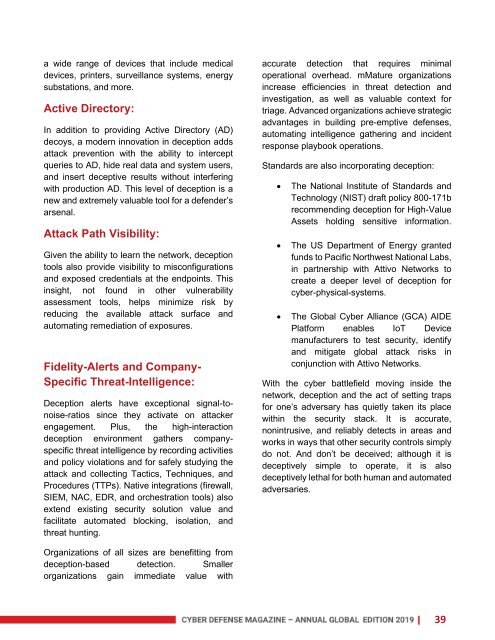Cyber Defense Magazine Global Edition for 2019
Cyber Defense Magazine's Annual Global Edition for 2019: Will Quantum resilient encryption change the future against breaches in our favor? Can deception technology stop the next wave of cybercriminals? This and much more inside this 78 page eMagazine exclusively distributed at www.ipexpoeurope.com each year along with our announcement of the Cyber Defense Global Awards winners for 2019; also found at www.cyberdefenseawards.com.
Cyber Defense Magazine's Annual Global Edition for 2019: Will Quantum resilient encryption change the future against breaches in our favor? Can deception technology stop the next wave of cybercriminals? This and much more inside this 78 page eMagazine exclusively distributed at www.ipexpoeurope.com each year along with our announcement of the Cyber Defense Global Awards winners for 2019; also found at www.cyberdefenseawards.com.
Create successful ePaper yourself
Turn your PDF publications into a flip-book with our unique Google optimized e-Paper software.
a wide range of devices that include medical<br />
devices, printers, surveillance systems, energy<br />
substations, and more.<br />
Active Directory:<br />
In addition to providing Active Directory (AD)<br />
decoys, a modern innovation in deception adds<br />
attack prevention with the ability to intercept<br />
queries to AD, hide real data and system users,<br />
and insert deceptive results without interfering<br />
with production AD. This level of deception is a<br />
new and extremely valuable tool <strong>for</strong> a defender’s<br />
arsenal.<br />
Attack Path Visibility:<br />
Given the ability to learn the network, deception<br />
tools also provide visibility to misconfigurations<br />
and exposed credentials at the endpoints. This<br />
insight, not found in other vulnerability<br />
assessment tools, helps minimize risk by<br />
reducing the available attack surface and<br />
automating remediation of exposures.<br />
Fidelity-Alerts and Company-<br />
Specific Threat-Intelligence:<br />
Deception alerts have exceptional signal-tonoise-ratios<br />
since they activate on attacker<br />
engagement. Plus, the high-interaction<br />
deception environment gathers companyspecific<br />
threat intelligence by recording activities<br />
and policy violations and <strong>for</strong> safely studying the<br />
attack and collecting Tactics, Techniques, and<br />
Procedures (TTPs). Native integrations (firewall,<br />
SIEM, NAC, EDR, and orchestration tools) also<br />
extend existing security solution value and<br />
facilitate automated blocking, isolation, and<br />
threat hunting.<br />
accurate detection that requires minimal<br />
operational overhead. mMature organizations<br />
increase efficiencies in threat detection and<br />
investigation, as well as valuable context <strong>for</strong><br />
triage. Advanced organizations achieve strategic<br />
advantages in building pre-emptive defenses,<br />
automating intelligence gathering and incident<br />
response playbook operations.<br />
Standards are also incorporating deception:<br />
• The National Institute of Standards and<br />
Technology (NIST) draft policy 800-171b<br />
recommending deception <strong>for</strong> High-Value<br />
Assets holding sensitive in<strong>for</strong>mation.<br />
• The US Department of Energy granted<br />
funds to Pacific Northwest National Labs,<br />
in partnership with Attivo Networks to<br />
create a deeper level of deception <strong>for</strong><br />
cyber-physical-systems.<br />
• The <strong>Global</strong> <strong>Cyber</strong> Alliance (GCA) AIDE<br />
Plat<strong>for</strong>m enables IoT Device<br />
manufacturers to test security, identify<br />
and mitigate global attack risks in<br />
conjunction with Attivo Networks.<br />
With the cyber battlefield moving inside the<br />
network, deception and the act of setting traps<br />
<strong>for</strong> one’s adversary has quietly taken its place<br />
within the security stack. It is accurate,<br />
nonintrusive, and reliably detects in areas and<br />
works in ways that other security controls simply<br />
do not. And don’t be deceived; although it is<br />
deceptively simple to operate, it is also<br />
deceptively lethal <strong>for</strong> both human and automated<br />
adversaries.<br />
Organizations of all sizes are benefitting from<br />
deception-based detection. Smaller<br />
organizations gain immediate value with<br />
39


















